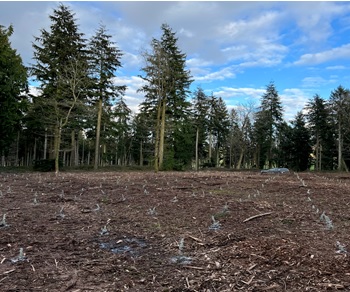FOCUS ON TREE PROTECTION
Forest Research have published updated guidance on the Integrated Management of Hylobius abietis.
The report summary recommends that an integrated approach to the management of this pest is adopted. This involves understanding the lifecycle and likely impacts of Hylobius, and then considering the full range of potential approaches available to prevent the insect damaging young trees, and finally selecting a restocking strategy that may involve single or multiple techniques in combination with each other.
A copy of the above report can be downloaded.
TRICO® Deer repellent
[with thanks to Ben Watson, forest manager with Bowlts Chartered Surveyors, Phil Di-Duca of Kelpie Woodlands, and Simon Webb who provided feedback and photographs from their experiences of using Trico].
Phil has used Trico on a couple of different sites as follows:
On semi mature trees planted for landscape where there is a population of red deer – multiple branches were sprayed to stop browsing. It was effective and trees were not browsed – lasted about two months then wore off and then saw signs of some nipping of the shoots. Re- applied twice in the year.

Photo: S Webb
On newly panted hedging – The estate used Trico on a section of new hedge plants and it protected trees from browsing by both Sika Deer and Hares. Again two applications in the season required.
Restock planting on large site with transient population of red deer with hinds we could not shoot out of season – only used on Scots pine as they are more susceptible to browsing/pulling up by deer. Cell grown trees so sprayed prior to planting – effective for period allowing us to control deer.
Used on mixed broadleaves in 1.2m shelters where we were getting damage by red deer coming in from neighbouring land which were targeting each tree as it emerged from shelters. Effective to deter deer but will require two applications per year until trees are higher than browsing height or deer are removed.

Photo: S Webb
Can also use as a band spay around smaller areas or a tree store whilst trees are awaiting planting in one area as in this photo.
Application – we have tried with knapsack sprayer and hand held sprayers – both have issues as the Trico is a thick emulsion a bit like white emulsion paint so it can clog up nozzles. Only fill with enough for the days work and ensure you have a large nozzle and empty tanks completely and wash out carefully otherwise it dries within tank and hoses/nozzles. Only apply if trees are dry and no rain forecast as it needs to dry onto the tree and it is visible as a white emulsion. It does not smell.
Simon has reported that from spraying in-situ on several sites in southern England, selection of nozzle size is all important; he has not experienced clogging and found that if nozzle size is too large it results in over application and wastage. It is possible that the ambient temperature on sites that are 600 miles apart may be an important factor.
Ben has shared a few pictures of TRICO effectiveness on Norway spruce in a forest near Rothes where restocking was unfenced.

Photo: B Watson
The Norway is pretty much untouched despite reasonable deer pressure from both red and roe. You can see tip browsing on regenerated Sitka on the photo to the left.

Photo: B Watson
You can see the browsing on the bark of windblow in this picture whilst the Norway remains untouched. It was treated at time of planting and again in October time. The pictures were taken in mid February. The only real mortality on site is weevil and it is almost entirely unbrowsed.

Photo: P Di-Duca
You can dip the trees prior to planting and the Trico will dry so ok to handle and plant. You just have to watch that the trees don’t stick together. The coating does not affect the buds from bursting through.
This is a lot quicker to treat large numbers of bare root trees pre plant.
Makes planters able to easily see which mounds are planted too!

Photo: S Webb
Price – around £14 per litre so all depends on size of tree you are spaying to amount used.
Phil says he will keep using it for sites where there are deer or hare issues and where there is limited control over the deer populations – i.e. transient deer from neighbours or out of season restrictions or areas where deer cannot be controlled safely – public access or in urban sites.
Plant Health Webinars
Update on the series of free webinars for 2022 provided by Forestry Commission
Oak Processionary Moth – Wednesday 23rd March 9:00am Book here
Phytophthora pluvialis – Tuesday 5th April 10:00am Book here
UKFCG Re-evaluation audit conducted by Soil Association 23rd April – Mid May
Thank you to all the forest managers who have been selected for the audit, 11 sites in all, from a membership of 160. UKFCG will soon be 10 years old, from a start in 2012 with 16 members we are pleased to have supported all our members with their certification needs.
Welcome to new members who have joined us so far this year:
Dalnacradoch Estate Corsock Forestry Old Boghead
Penicuil Estate Drumelzie Lincluden Estate
Bernisdale Wood Glenapp Estate Arniston Estate
Yarrow Woodlands Scone Estates Strathbran Estate
Sourden Scaniport
